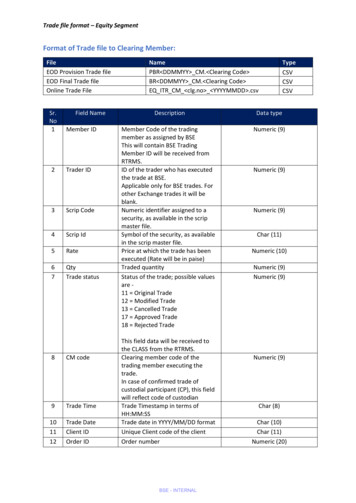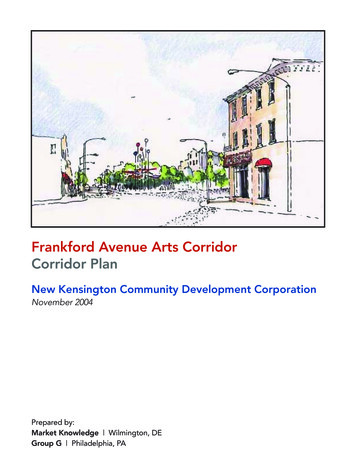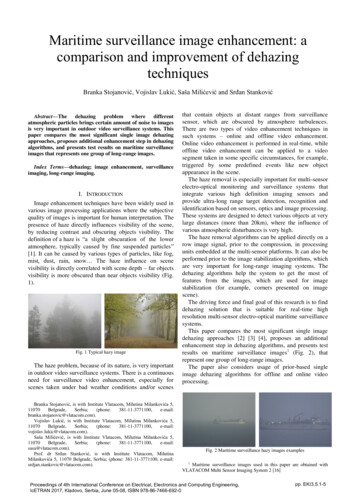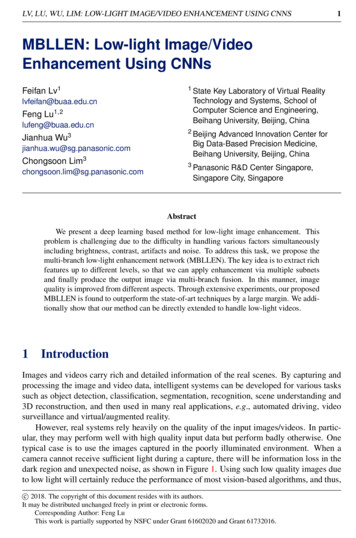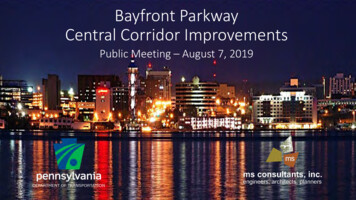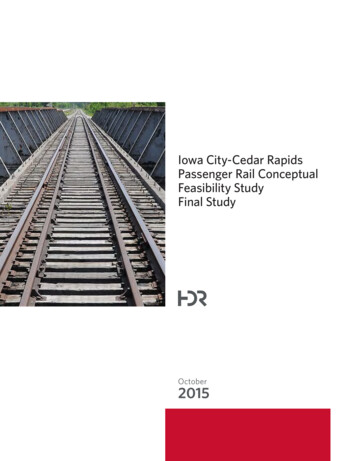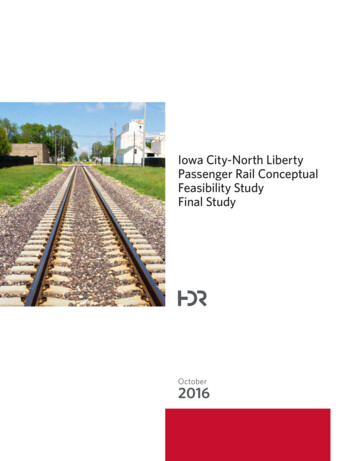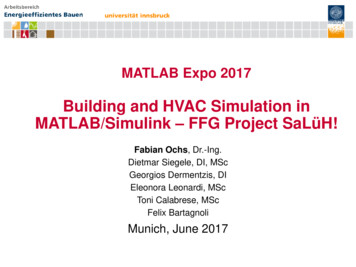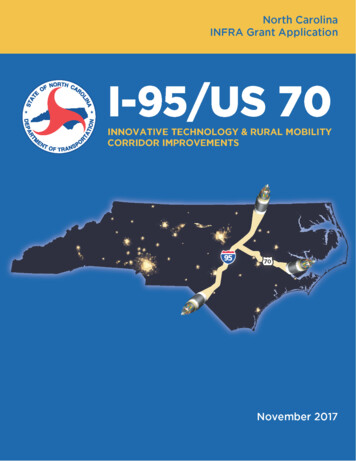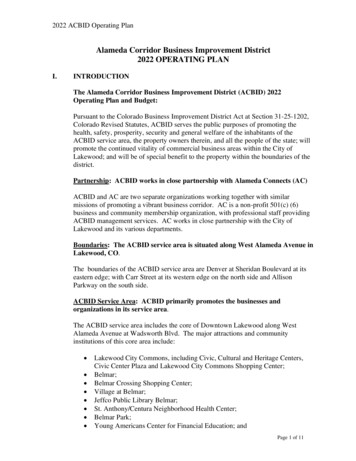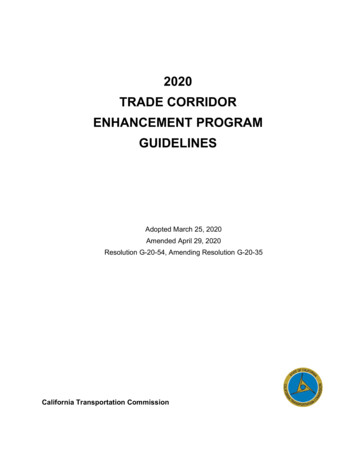
Transcription
2020TRADE CORRIDORENHANCEMENT PROGRAMGUIDELINESAdopted March 25, 2020Amended April 29, 2020Resolution G-20-54, Amending Resolution G-20-35California Transportation Commission
California Transportation Commission2020 Trade Corridor Enhancement Program GuidelinesFinal GuidelinesAdopted March 25, 2020Amended April 29, 2020CALIFORNIA TRANSPORTATION COMMISSION2020 TRADE CORRIDOR ENHANCEMENT PROGRAM GUIDELINESI.Introduction . 3Authority and Purpose. 3Program Objectives . 3Program Schedule . 4II.Funding . 4Funding and Program Cycle . 4Distribution . 4Matching Requirements. 6Leveraging Federal Discretionary Funds . 7Funding Restrictions . 8Reimbursement . 9Eligible Applicants . 9Eligible Projects . 9Eligible Components . 11Delivery Methods . 11Project Segmenting . 12Multimodal Projects / Modes / Contracts . 12Screening Criteria . 12Project Rating Process . 13Evaluation Criteria . 14Programming Capacity . 16Program of Projects . 16Committed/Uncommitted Funds . 16III. Project Amendments . 17Amendment Requests . 17Allocation Requests . 18Letter of No Prejudice . 20Timely Use of Funds . 20Delivery Deadline Extensions . 211
California Transportation Commission2020 Trade Corridor Enhancement Program GuidelinesFinal GuidelinesAdopted March 25, 2020Amended April 29, 2020Project Inactivity . 21Project Cost Savings . 21Project Reporting . 22Project Tracking Database . 22Project Auditing . 22Project Signage . 22IV.Attachments . 23Attachment 1. Trade Corridor Enhancement Program Goals and GuidingPrinciples . 23Attachment 2. California Freight Mobility Plan Goals and Objectives . 26Attachment 3. 2020 California Freight Mobility Plan Critical FreightInvestment Themes . 28Attachment 4. Project Nominations . 29Attachment 4. Appendix 1: Project Programming Request. 35Attachment 4. Appendix 2: Performance Metrics Instructions . 36Attachment 4. Appendix 3: Performance Metrics Form . 38Attachment 4. Appendix 4: State Highway System Project ImpactAssessment Instructions and Form (CTC-0002) . 42Attachment 4. Appendix 5: Fund Estimate . 44TABLE OF CONTENTS2
California Transportation Commission2020 Trade Corridor Enhancement Program GuidelinesFinal GuidelinesAdopted March 25, 2020Amended April 29, 2020I. IntroductionAuthority and PurposeThe Road Repair and Accountability Act of 2017 or Senate Bill (SB) 1 (Beall, Chapter 5,Statutes of 2017), established the Trade Corridor Enhancement Account to fundcorridor-based freight projects nominated by local agencies and the state.Implementing legislation was enacted with the approval of SB 103 (Chapter 95, Statutesof 2017) which directs the California Transportation Commission (Commission) toallocate the Trade Corridor Enhancement Account funds and the federal NationalHighway Freight Program funds to infrastructure improvements along corridors thathave a high volume of freight movement.The National Highway Freight Program was established with the approval of FixingAmerica’s Surface Transportation (FAST) Act, on December 4, 2015.The Commission is responsible for programming and allocating these state and federalfunds and the funds will be administered through the Trade Corridor EnhancementProgram.The Trade Corridor Enhancement Program guidelines build from the 2007 Proposition1B Trade Corridors Improvement Fund guidelines, which provided a one-time infusionof state funds for freight-related infrastructure improvements along corridors with a highvolume of freight movement.These guidelines describe the policy, standards, criteria, and procedures for thedevelopment, adoption and management of the Trade Corridor Enhancement Program.The guidelines were developed in consultation with stakeholders representing state,regional, and local government entities, advocacy groups and private industry.The Commission may amend these guidelines after first giving notice of the proposedamendments. The Commission will make a reasonable effort to amend the guidelinesprior to a call for projects or may extend the deadline for project submission in order tocomply with the amended guidelines.Program ObjectivesThe objective of the Trade Corridor Enhancement Program is to fund infrastructureimprovements on federally designated Trade Corridors of National and RegionalSignificance, on California’s portion of the National Highway Freight Network, asidentified in the California Freight Mobility Plan, and along other corridors that have ahigh volume of freight movement as determined by the Commission. The TradeCorridor Enhancement Program will also support the goals of the National HighwayFreight Program, the California Freight Mobility Plan, and the guiding principles in theCalifornia Sustainable Freight Action Plan. Attachment 1 provides a list of the variousgoals and guiding principles.3
California Transportation Commission2020 Trade Corridor Enhancement Program GuidelinesFinal GuidelinesAdopted March 25, 2020Amended April 29, 2020Program ScheduleThe following schedule lists the major milestones for the development and adoption ofthe Trade Corridor Enhancement Program:Present Draft Guidelines to CommissionJanuary 29, 2019Commission Adoption of GuidelinesMarch 25, 2020Call for Project ApplicationsMarch 25, 2020Project Applications due to Commission (postmarkdate)August 3, 2020Release Staff RecommendationsNovember 12, 2020Commission Adopts ProgramDecember 2, 2020II. FundingFunding and Program CycleThe 2020 Program will provide three years of programming in fiscal years 2020-21,2021-22, and 2022-23, for an estimated total of 1.001 billion ( 1,001,000,000) of TradeCorridor Enhancement Program funds. Any unused balance or savings generated willbe added to the available funding in the following cycle. Subsequent program cycleswill include two new years of programming.The 2020 Program funding will be developed based on the federal National HighwayFreight Program continuing under the next federal transportation act. If necessary,adjustments to the total program funding will be made at a later date. Over the threeyears in this programming cycle (2020-21, 2021-22, and 2022-23) it is estimated that 391 million ( 391,000,000) of National Highway Freight Program Funds will beavailable. A three-year Fund Estimate is provided in Appendix 5.DistributionThe Commission supports a corridor-based programming approach to the TradeCorridor Enhancement Program, which recognizes and complements the goodsmovement planning work already done within the major trade corridors. TheCommission also recognizes and supports the key role that the state and regions havein project identification.After consulting the California Freight Mobility Plan and conducting a number ofstakeholder workshops, the Commission has determined that the following corridors areeligible for funding under this program: Bay Area (Alameda, Contra Costa, Marin, Napa, San Francisco, San Mateo,Santa Clara, Solano, and Sonoma counties)4
California Transportation Commission2020 Trade Corridor Enhancement Program GuidelinesFinal GuidelinesAdopted March 25, 2020Amended April 29, 2020 Central Valley (El Dorado, Placer, Fresno, Kern, Kings, Madera, Merced,Sacramento, San Joaquin, Stanislaus, Sutter, Tulare, and Yolo counties) Central Coast (Monterey, San Benito, San Luis Obispo, Santa Barbara, andSanta Cruz counties) Los Angeles/Inland Empire (Los Angeles, Orange, Riverside, San Bernardino,and Ventura counties) San Diego/Border (Imperial and San Diego counties) Other (Alpine, Amador, Butte, Calaveras, Colusa, Del Norte, Glenn, Humboldt,Inyo, Lake, Lassen, Mariposa, Mendocino, Modoc, Mono, Nevada, Plumas,Shasta, Sierra, Siskiyou, Tahoe Basin Counties, Tehama, Trinity, Tuolumne, andYuba counties)The Commission acknowledges that other regions may have goods movementinfrastructure needs along corridors that have a high volume of freight movement thatare eligible for funding. The Commission anticipates those regions will nominate theirprojects for consideration.To promote a corridor-based approach while also recognizing the key role of the state inprioritizing interregional freight projects, the Commission has developed the followingtargets for projects nominated by the California Department of Transportation (Caltrans)and for the geographic programming of projects nominated by other agencies.Pursuant to Streets and Hiqhways Code, Section 2192, the target for Caltrans is 40% ofthe identified program funding. The remaining 60% is available for projects nominatedby regional transportation agencies and other public agencies, including counties, cities,and port authorities.In considering geographic balance for the overall program, the Commission mayprogram below the corridor-based targets in a region or regions to account for projectsprogrammed from the statewide target.Regional Corridor Target MethodologyCurrent adopted guidelines include funding targets for regional corridors that are basedon data that is more than ten years old. Commission staff is working with Caltrans andregional agencies to update these targets, but additional work is needed before amethodology can be finalized.For the 2020 Trade Corridor Enhancement Program, the 2018 regional corridor targetswill be used. Staff will continue to work with Caltrans and the regional agencies toupdate these targets for the 2023 program.The 2018 Trade Corridor Enhancement Program regional corridor targets were basedon the original Proposition 1B Trade Corridors Improvement Fund program targets,which were based on key freight indicators from the 2007 Goods Movement ActionPlan. Commission staff intend to use, in consultation with stakeholders, a similar5
California Transportation Commission2020 Trade Corridor Enhancement Program GuidelinesFinal GuidelinesAdopted March 25, 2020Amended April 29, 2020methodology to develop the 2023 Trade Corridor Enhancement Program regionalcorridor funding targets.The targets are neither minimums, maximums, nor guarantees. They do notconstrain what any agency may propose or what the Commission may approvefor programming and allocation within any particular corridor.Programming TargetsStatewide TargetCaltrans 556,800,000Regional Corridor TargetsPercentageTargetBay Area/Central Valley27% 225,504,000Central Coast2% 16,704,000Los Angeles/Inland Empire58% 484,416,000San Diego/Border11% 91,872,000Other2% 16,704,000Matching RequirementsProjects funded from the Trade Corridor Enhancement Program will require at least a30% match of private, local, federal, or state funds. For the purpose of calculating therequired match, the Commission will, except for State Transportation ImprovementProgram funding, only consider funds that are not allocated by the Commission on aproject specific basis. For projects nominated by Caltrans, no match will be required.However, as noted in Section 18, the Commission will consider the leveraging andcoordination of other funds when evaluating projects. For projects jointly nominated byCaltrans and another agency, the matching funds must account for 30% of the localagency’s share of the project costs.The matching funds must be expended concurrently and proportionally on the projectcomponent programmed with Trade Corridor Enhancement Program funds, except asnoted below. Costs incurred prior to allocation will not be counted towards match.The Commission may, at the time of programming or allocation, approve nonproportional spending. For projects receiving federal National Highway Freight Programfunds, the non-proportional spending must be approved by the Federal HighwayAdministration prior to allocation. Adjustments will be made at project closeout toensure matching funds were spent proportionally to the Trade Corridor EnhancementProgram funds.6
California Transportation Commission2020 Trade Corridor Enhancement Program GuidelinesFinal GuidelinesAdopted March 25, 2020Amended April 29, 2020The applicant must provide a project funding plan through construction thatdemonstrates the supplemental funding in the plan (local, federal, state, privatesources) is reasonably expected to be available and sufficient to complete the project.The investment of public funding must be tied to public benefits as demonstratedthrough a public/private benefit cost analysis. The benefit cost analysis should take intoaccount who owns the asset once the project is completed.Priority will be given to projects that have committed discretionary federal funds at timeof project nomination. The commitment should be in the form of a letter or publicannouncement issued by the authorizing federal agency.Leveraging Federal Discretionary FundsThe Commission will program up to 50 percent of the applicable regional corridor targetto match a project that has been awarded federal funds in the 2020 Infrastructure forRebuilding America (INFRA Grant) program, if the project is otherwise eligible under theTrade Corridor Enhancement Program.Caltrans is encouraged to demonstrate support for INFRA Grant projects by committingto provide financial assistance from their 40 percent of statewide Trade CorridorEnhancement Program funding.For INFRA Grant projects that are jointly nominated by Caltrans and another agency, theprogrammed amount will be equally split between the statewide amount and up to 50percent of the applicable regional corridor target. In the event the amount available fromthe regional corridor target is less than one half of the programmed amount, the differencewill be taken from the statewide target. For all other INFRA Grant projects, theprogrammed amount will be taken from up to 50 percent of the applicable regional corridortarget.Prior to the project being programmed, project applicants must submit a complete TradeCorridor Enhancement Program nomination form included in these guidelines asAttachment 4. The project may be programmed and allocated prior to the adoption ofthe Trade Corridor Enhancement Program of projects in December of 2020 but notbefore the INFRA Grant funding is awarded. In the event the INFRA Grant funding isawarded after the December 2020 program adoption, the appropriate targets will beadjusted in the next program cycle.If more than one INFRA Grant project from the same regional corridor is awardedINFRA Grant funds and requests funds under this section, up to 50 percent of theapplicable regional corridor target will be distributed to eligible projects proportionallybased on the total amount of non-federal match requested.Recipients of INFRA Grant funding must provide the Commission a copy of the INFRAgrant application, documentation of the official award of INFRA grant funds within 15days of receipt of the notice of award, along with a cover letter describing how theproject is eligible for Trade Corridor Enhancement Program funding. The allocation offunds will be processed as outlined in Section 23 of these guidelines.7
California Transportation Commission2020 Trade Corridor Enhancement Program GuidelinesFinal GuidelinesAdopted March 25, 2020Amended April 29, 2020If an INFRA Grant project is programmed under this section, Commission staff will takethis into account when reviewing applications submitted by that same entity as part ofthe call for projects.In the event a project is successful in the Trade Corridor Enhancement Program and inreceiving an INFRA Grant, the Commission will program state funds to the project ratherthan the federal National Highway Freight Program funds so long as the project meetsArticle XIX requirements.The Commission will consider providing matching funds for other federal discretionaryfunding programs where the federal Notice of Funding Opportunity application periodfalls within the first year of the Trade Corridor Enhancement Program cycle, or wherefunds from a recent application are awarded within the first year of the program cycle.The project must demonstrate a significant freight benefit. If funds are awarded forother federal discretionary grants, the language in this section related to INFRA Grantswill also apply to these grants, including the limit on available funds of up to 50 percentof the applicable regional corridor target.Commission staff will work with stakeholders to develop a process to address all federaldiscretionary funds and will include it in the next update of the guidelines.Funding RestrictionsTrade Corridor Enhancement Program funds shall not supplant other committed fundsand are not available to fund cost increases except as noted below. Trade CorridorEnhancement Program funds shall not be shifted between programmed projectcomponents.Trade Corridor Enhancement Program funding may be used to fund cost increases onCaltrans nominated projects. The statewide target in future programming cycles will beadjusted accordingly. The Commission will allocate the cost increase on a project byproject basis consistent with Section 23 of these guidelines. For jointly nominatedprojects, the Commission expects cost increases will be funded based on agreementsbetween the agencies nominating the project.Projects must commence right-of-way acquisition or actual construction with-in 10 yearsof receiving pre-construction funding through the Trade Corridor EnhancementProgram, or the implementing agency must repay the Trade Corridor EnhancementProgram funds. Repaid funds will be made available for redistribution in the subsequentprogramming cycle.Projects on the state highway system and/or projects implemented by Caltrans require aCaltrans approved Project Initiation Document if requesting funds for the ProjectApproval and Environmental Document component, and a Caltrans approved ProjectReport for all other components.Project nominations requesting funds for Project Approval and EnvironmentalDocument, will not be considered for funding for Plans, Specifications, and Estimates;8
California Transportation Commission2020 Trade Corridor Enhancement Program GuidelinesFinal GuidelinesAdopted March 25, 2020Amended April 29, 2020Right-of-Way; or Construction in that program cycle. However, this does not precludean entity from requesting Trade Corridor Enhancement Funds for another component ina future program cycle.A project that is already fully funded or is a capital improvement that is required as acondition for private development approval or permits is not eligible for funding from theTrade Corridor Enhancement Program.ReimbursementThe Trade Corridor Enhancement Program is a reimbursement program for eligiblecosts incurred. An agency may begin incurring eligible costs upon allocation, however,reimbursement is dependent upon entering into an agreement with Caltrans. Costsincurred prior to Commission allocation and, for federally funded projects, FederalHighway Administration project approval (i.e. Authorization to Proceed) are not eligiblefor reimbursement.Eligible ApplicantsEligible applicants include local, regional, and public agencies such as cities, counties,Metropolitan Planning Organizations, Regional Transportation Planning Agencies, portauthorities, public construction authorities, and Caltrans. Project proposals from privateentities must be submitted by a public agency sponsor.The Commission expects collaboration and cooperation between the applicant,implementing agency, and Caltrans for all projects on the state highway system.A nomination may identify an entity other than the applicant to be the projectimplementing agency. The implementing agency assumes responsibility andaccountability for the use and expenditure of program funds.Applicants and implementing agencies must comply with all relevant federal and statelaws, regulations, policies, and procedures.The Metropolitan Planning Organizations will be responsible for compiling projectnominations from their respective agencies as described in Attachment 4 ProjectNominations.Eligible ProjectsA freight project is a project that significantly contributes to the freight system’seconomic activity or vitality; relieves congestion on the freight system; improves thesafety, security, or resilience of the freight system; improves or preserves the freightsystem infrastructure; implements technology or innovation to improve the freightsystem or reduce or avoid its negative impacts; or reduces or avoids adversecommunity and/or environmental impacts of the freight system; or improves systemconnectivity.9
California Transportation Commission2020 Trade Corridor Enhancement Program GuidelinesFinal GuidelinesAdopted March 25, 2020Amended April 29, 2020To be eligible for funding under this program, a project must meet the aforementionedfreight project definition, support the objectives of the program, and meet the screeningand evaluation criteria.Projects receiving state funds must be consistent with Article XIX of theCalifornia Constitution.Projects receiving federal National Highway Freight Program funds must comply withthe provisions of Section 167 of Title 23 of the U.S. Code of Federal Regulation and belocated on the Primary Highway Freight System or a designated Critical Rural FreightCorridor or Critical Urban Freight Corridor. The designation of the Critical Rural FreightCorridor or Critical Urban Freight Corridor is not required at the time of projectnomination; however, the designation must be federally approved prior to the projectrequesting allocation. Grade Crossing improvement projects, Grade Separationprojects, Intermodal projects, and Intelligent Transportation System projects are notrequired to have a Critical Rural Freight Corridor or Critical Urban Freight Corridordesignation.Pursuant to federal statute, the Commission may not program more than 10 percent ofthe total federal yearly apportionment amount for freight intermodal or freight railprojects, which include the following: Projects within the boundaries of public or private freight rail or water facilities(including ports). Projects that provide surface transportation infrastructure necessary to facilitatedirect intermodal interchange, transfer, and access into or out of the facility.Projects eligible for funding under the program include, but are not limited to, thefollowing: Highway improvements to more efficiently accommodate the movement offreight, particularly for ingress and egress to and from the state’s land ports ofentry, rail terminals, and seaports, to relieve traffic congestion, along major tradeor goods movement corridors. Freight rail system improvements to enhance the ability to move goods fromseaports, land ports of entry, and airports to warehousing and distributioncenters, including grade separations. Port capacity and efficiency enhancements, excluding the purchase of fullyautomated cargo handling equipment. Truck corridor improvements, including dedicated truck facilities or truck tollfacilities, including the mitigation of the emissions from trucks or these facilities. Border access improvements to enhance goods movement. Surface transportation, local road, and connector road improvements toeffectively facilitate the movement of goods, particularly for ingress and egress to10
California Transportation Commission2020 Trade Corridor Enhancement Program GuidelinesFinal GuidelinesAdopted March 25, 2020Amended April 29, 2020and from the state’s land port of entry, airports, and seaports, to relieve trafficcongestion along major trade or goods movement corridors. Port and/or rail projects to facilitate intermodal interchange, transfer, and accessinto or out of the facility (limited to 10% of federal yearly apportionments). Advanced Technology – Projects that employ advanced and innovativetechnology to improve the flow of freight, such as Intelligent TransportationSystems (ITS), public infrastructure (excluding vehicles) that enables zeroemission or near-zero emission goods movement, real time information systems,weigh-in-motion devices, electronic screening/credentialing systems, traffic signaloptimization, work zone management and information systems, ramp metering,electronic cargo and border security technologies. Environmental/community mitigation, or efforts to reduce environmental impactsof freight movement, such as projects that reduce noise, overnight truck idling, ortruck queues and advanced traveler Information Systems such as FreightAdvanced Traveler Information Systems (FRATIS).Eligible ComponentsTrade Corridor Enhancement Program funds may be used for any project component(project approval and environmental document; plans, specifications, and estimates;right-of-way; and construction), however, right of way and construction capital costs willonly be programmed if the project has completed a project level environmental processin accordance with the California Environmental Quality Act (CEQA), within six monthsof program adoption. If the project level environmental document is not filed within sixmonths, the project will be deleted from the program.Delivery MethodsThe Commission supports and encourages innovative delivery methods. If a project isexpected to use a delivery method other than design-bid-build, the nomination shouldidentify the delivery method as part of the proposal. If the delivery method is unknown attime of nomination, it should be reported as soon as it is known.For a project expected to use design-build or design-sequencing delivery method, theCommission will program the Trade Corridor Enhancement funds in the constructioncomponent of the project. The allocation however may be a combined amount toinclude design, right-of-way, and construction.When using the Construction Manager/General Contractor delivery method, the projectwill be programmed and allocated in the same manner as design-bid-build. During theenvironmental or design phase, Construction Manager/General Contractor contractcosts are considered environmental and/or design phase expenditures. As the projectadvances in the design phase, it may be desirable to separate the project into packagesfor efficiencies in the construction delivery. If this is the case, the project may beseparated into separate delivery contracts and the Commission must be notified as11
California Transportation Commission2020 Trade Corridor Enhancement Program GuidelinesFinal GuidelinesAdopted March 25, 2020Amended April 29, 2020soon as possible. The delivery dates and the scope of work must be consistent with theapproved baseline agreement. If there is a change in cost, the change must beidentified as specified in Section 22.Project SegmentingScaling a proj
The 2018 Trade Corridor Enhancement Program regional corridor targets were based on the original Proposition 1B Trade Corridors Improvement Fund program targets, which were based on key freight indicators from the 2007 Goods Movement Action Plan. Commission staff intend to use, in consultation with stakeholders, a similar
